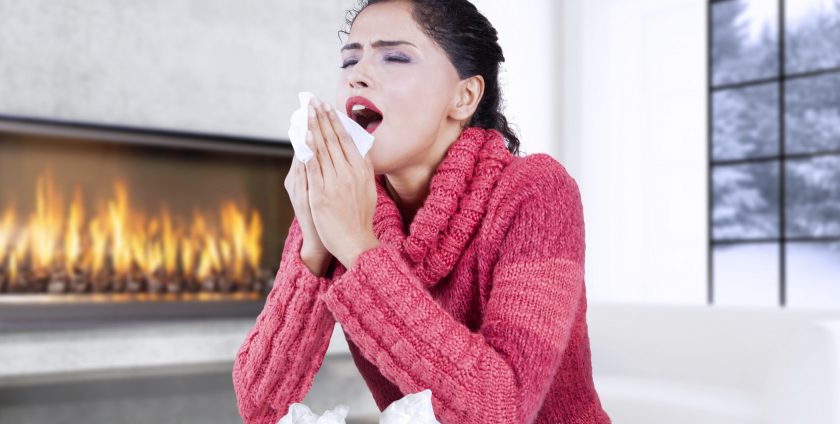Winter is Here and So Are The Cold Weather Allergies

When most people think of winter, they think holidays, a roaring fire, and comfy sweaters. But, winter’s cold weather also brings the less than ideal imagery of mold spores, wood smoke, and even wool fiber allergens. True, not the most festive vision, but when it comes to indoor air quality, minimizing allergy triggers will help you enjoy this winter season.
Below is a list of common indoor allergens that are magnified during the cold weather and tips on how to negate their impact.
1. Fireplace smoke
When relaxing by the fire, it’s only natural to focus on the comforting warmth. And not the smoke we’re breathing in, especially since it’s not something we can see. Indoor wood fires, however, produce common irritants that can cause congestion, itchy eyes, and a sore throat. You can lessen or even eliminate these symptoms first and foremost by not sitting too close. Tempting as it is to feel the heat when it’s chilly, you’ll be breathing in way more smoke than you realize. Another way to keep the air quality at a good level is to make sure that the area is well ventilated.

When lighting the fire, close all windows and doors and make sure the clothes dryer and any exhaust fans are off. The airflow caused by these factors can disrupt the air draft up through the vent in extremely cold weather, thus preventing proper ventilation. Lastly, you might not realize that wood stored outside absorbs moisture, making it a haven for mold spores. If possible, keep firewood in the garage or in a dry area to keep moisture at a minimum.
2. Pet dander
Though pet dander can affect us throughout the year, it’s safe to assume that Rover and Kitty are spending more time indoors during the chilly months. Factor in the heavier coats of fur that nature provides them during winter, and you’re bound to experience a much more intense dander experience.

One way to lessen the dander effect is to keep it clean. Vacuum more frequently and wash pet blankets and bedding often. Changing clothes and washing up after playing with your pet is a good idea, and bathing pets regularly with a mild pet shampoo will wash away dander and other allergens from their fur. Lastly, make sure to brush them outside if possible so that loose dander and fur stays on the other side of the door.
3. Mold and mildew
Most people assume that mold and mildew are a warm weather issue caused by humidity. However, they can grow rampant in cold weather, too. Precipitation like snow combined with the dramatic differences in temperature between the outdoors and indoors creates the perfect environment for condensation.

For example, if warm air from your home rises into the attic where it’s cool, or comes in contact with a cold window, condensation ensues. This will cause mold and mildew to thrive, causing sneezing, coughing, headaches, and general malaise. We found some great tips from the EPA on how to lessen the impact of mold and mildew this winter:
- Open doors and/or windows when possible to increase ventilation.
- Use an exhaust fan when cooking and when showering.
- Keep indoor humidity low; increase air temperature.
- Notice condensation and moisture as it collects on windows, walls, or pipes. Dry the wet surface and attempt to reduce the source of water or moisture.
- Clean and repair roof gutters regularly.
- Cover cold surfaces, such as cold water pipes, with insulation.
- Change air filters regularly. Dirty filters limit air flow and can encourage mold if moisture gets trapped.
4. Dust mites
Though it’s a year-round issue, dust mite allergies can be worse during the winter months. We spend more time indoors with windows and doors closed and ventilation almost non-existent.
Just to give you some background, dust mites are microscopic bugs that live on the dead skin cells that we humans and our pets shed daily (which, by the way, is mostly what dust is made of). With the cold weather and increased dry skin during the winter months, we tend to shed more. Though dust mites are harmless in that they don’t carry diseases, bite, or sting, they can cause allergic reactions in asthmatics and others. Obviously, reducing the amount of dust in your home will help to improve any allergy symptoms.
Again, we suggest that you sweep, vacuum, and of course dust frequently, and wash bedding and blankets often and in hot water over 130ºF at least twice a week. You may want to also invest in allergy-proof covers on mattresses, pillows, and comforters, which can help. And as comfy as they are, avoid down pillows and comforters as they create the perfect camping ground for dust mites (plus down can be an allergen in and of itself).
5. Wool
Oh how we love to move our short sleeve tops to the back of the closet and make way for our cool and comfy sweater collection. What we don’t realize is that while sweaters, scarves, and hats protect us from the elements, their wool fibers can also irritate our skin and affect our breathing. Some people may break out in red itchy bumps; others could have watery eyes and a sneezing fit.
While the idea of purging your wardrobe of your favorite wool sweaters may not be appealing, there is not a whole lot that you can do to diminish your reaction to wool fibers. You can try wearing an undershirt or cami under the wool garment to lessen the amount of skin that’s in contact with it. You can also ask your doctor for an appropriate allergy treatment to help you ride out your fashion commitment. Or, you can just ditch those sweaters (the best choice) and go for garments made from higher-grade wools or materials such as merino, silk, hemp, alpaca, fleece, cashmere, or wool blend material without the coarse fibers. Fun fact: some of the allergies to sheep’s wool is actually caused by lanolin, which sheep naturally secrete. If your sweater is giving you allergy symptoms, you may want to check the soaps and lotions that you’re using as well.
6. Forced air furnaces
So, the weather outside is frightful and it’s time to put on the heat for the first time in months. Keep in mind that once you kick the heat on that first time, months of collected dust, lint, fabric fiber, bacteria, food material, and animal dander become airborne (which is what can cause that first-heat smell). The best way to avoid this before you put the heat on is to call an HVAC professional for a maintenance inspection. Ask them to clean the furnace, change the filter, check for leaks, and clean the furnace ducts. Yes, it’s an extra expense, but it can save you days (even weeks) of allergen irritation.
If this is not in your budget, then you can try to clean air vents and returns yourself, though we always recommend leaving those things to a professional. Most heating units only recirculate the existing air in your home, including all those inside allergens. Consider adding a HEPA filter on your central furnace, which will trap dust mites and mold spores for the entire house.
7. Keeping indoor air fresh… making small changes can bring healthy winter benefits
 Winter means more time indoors so why not treat yourself to little improvements that can impact the air you are breathing this season.
Winter means more time indoors so why not treat yourself to little improvements that can impact the air you are breathing this season.
- Consider an air purifier. With plenty of options and one for every budget, they can reduce airborne particle pollution and harmful VOCs in your home.
- Bring a garden indoors. Indoor plants won’t only lift your spirits on gloomy days, but will help eliminate carbon dioxide, boost oxygen levels, and help to purify your home’s air of toxic chemical vapors. Choose a Ficus, Peace Lily, Palm, or English Ivy.
- Avoid toxic chemical cleaning products, especially in the winter, if you can’t open windows. Instead opt for natural cleaners like baking soda or vinegar and Greenguard Gold Certified Bona products for your hardwood floors.
- Limit the use of air fresheners when windows are closed as some have harmful VOCs and can be an irritant. Try eucalyptus or rosemary in bathrooms, lemon simmering in a pan, or oranges studded with clove to eliminate odors and add a fresh, clean smell.
- Don’t wait for spring, treat yourself to tulips. They are great for purifying air.
- And to help with mustiness and pet odors that seem to linger during the long winter months, try zeolite, an odorless volcanic rock known to eliminate unwanted air scents.
So just because the weather is cold and you experience coughing, sneezing, and congestion, doesn’t necessarily mean you have a cold. You might be experiencing allergic reactions to your closed-up, heated-up, indoor environment. Try some (or all) of these tips this winter and feel the difference.
Leave a Reply
